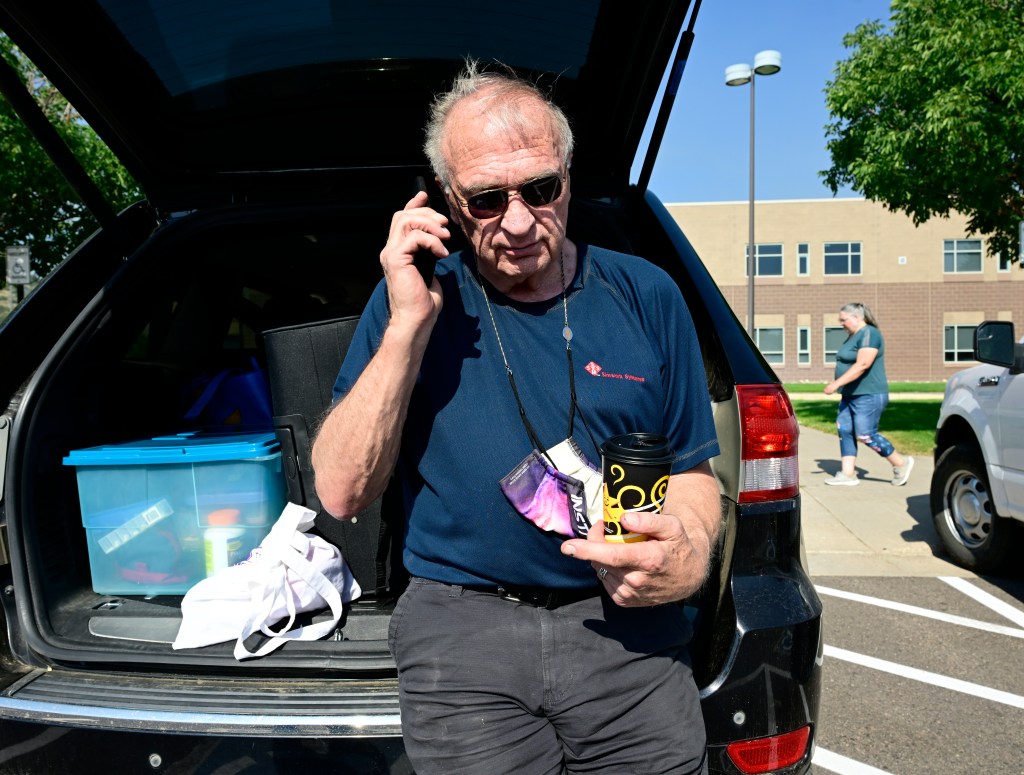As wildfires burned thousands of acres across the Front Range on Wednesday, some residents heeded early morning calls to leave while others opted to stay put on land that already required extra self-sufficiency.
At the Dakota Ridge High School, the evacuation site for the Quarry fire burning near Deer Creek Canyon in Jefferson County, John Banks coughed in the parking lot as smoke from the fire threatening his neighborhood hung heavily in the air.
Banks and his wife, Diane, fled the fire early Wednesday after a 1:30 a.m. phone call ordered them to evacuate.
The couple slept in their car overnight with their rescue cat, Mea, and the few items they scooped from their home after the evacuation call: medications, some clothes, John’s oxygen tanks and cancer medications, and Mea’s food and litter.
They left everything else behind in the home where they’ve lived for 34 years.
“These are just things,” said Banks, 78.
He paused, emotion creeping into his voice.
“If you lose things, you still have your friends, your family.”
The couple found a hotel to stay in for the next night and planned to spend Wednesday going to pre-scheduled doctor appointments.
“Life throws spitballs at you,” John Banks said. “But you keep going.”
When the couple arrived at the evacuation center at Dakota Ridge High School at 3 a.m. Wednesday, they were one of the first people to arrive.
By 9 a.m., dozens of cars were parked at the school — some of the nearly 600 households ordered to evacuate from the Quarry fire. A few evacuees took time to walk their dogs. In the next lot over, a Denver Fire Department crew suited up to respond to the fire.
Elden Coombs, 85, sat with his neighbors in the parking lot waiting for news. He moved to the Homewood Park neighborhood in 1969 and has lived through two other fires, a blizzard and two floods.

He left his home after getting the evacuation call at about 2 a.m. He grabbed some clothes, important documents and his medicine and fled.
“I haven’t been to bed,” he said. “I just hope they get the fire under control.”
At the frontlines of the Stone Canyon fire north of Lyons, Boulder County sheriff’s Sgt. Cody Sears patrolled the still-unburned areas where flames were flaring and spreading.
“So far, so good. We’ll see what the winds do,” Sears said as he rolled out around 11 a.m. Wednesday
He went first to an area where flames had taken a run to the northeast, threatening evacuated houses a couple of miles north of Lyons, then headed to terrain straddling Boulder and Larimer counties, a few miles south of the Alexander Mountain Fire — where residents apparently had elected to stay, hunkering down on their land.
Through smoke on Dakota Ridge Road, Sears spotted two horses: one brown, one white. He radioed county animal control crews, alerting them to a possible rescue. He was uneasy. “This fire is still really active,” he said.
But he and fellow officers, reaching homes there, found residents well in control.
At a front door in the area, Carmen Roberts, 50, came to the door and told him she and her family had stayed through the night. They had water tanks, heavy equipment, and were ready to evacuate with their horses if the flames came too close, she said.

“We’ve have been here over 30 years. We’ve been through these things several times,” Roberts said. “We have everything packed, out by the door. We are going to go if we need to.”
They’d slept a bit through the night. “When it happens over and over and over, the stress is less,” she said.
Yet fire perils seem to be increasing along Colorado’s Front Range, Roberts acknowledged. The problem is more and more people moving in, she said. “Fire is worse now because it affects more people. It is threatening more homes because there are more homes around.”
Near the top of Stone Canyon, business owner Matthew Lee, too, had spent the night on his property — 80 acres where he’d grazed cattle this spring before moving them away about three weeks ago, leaving the grass short enough to ease his worries.
The fire was burning within a quarter mile of his metal-roofed house.
He’d parked down the hill and, leaning on the back of his truck, looked upward. On Tuesday night, power went out at 10:30 p.m. and his cellphone went dead, said Lee, 55.
Early Wednesday, he told Sears, flames crested over the ridge. Slurry bombers dropped red fire retardant on that terrain as he watched.
He had declined to evacuate — like other self-reliant residents in the foothills north of Lyons. He lauded Colorado’s approach of aggressive fire suppression, dousing flames before fires can run their natural course.
“The most I have seen,” he said. “Yesterday, it was an air show. That’s good.”
Originally Published:

